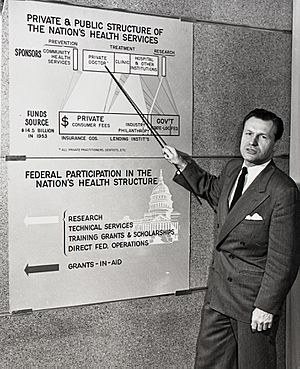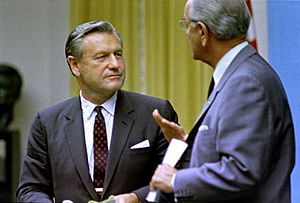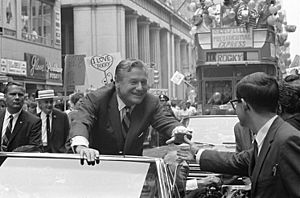Nelson Rockefeller facts for kids
Quick facts for kids
Nelson Rockefeller
|
|
|---|---|
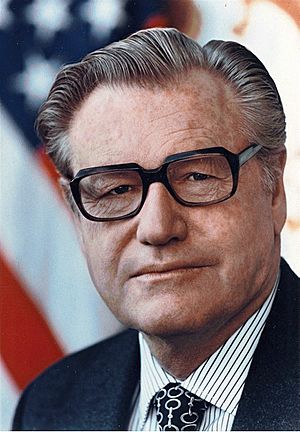
Official portrait, 1975
|
|
| 41st Vice President of the United States | |
| In office December 19, 1974 – January 20, 1977 |
|
| President | Gerald Ford |
| Preceded by | Gerald Ford |
| Succeeded by | Walter Mondale |
| 49th Governor of New York | |
| In office January 1, 1959 – December 18, 1973 |
|
| Lieutenant | Malcolm Wilson |
| Preceded by | W. Averell Harriman |
| Succeeded by | Malcolm Wilson |
| 1st Under Secretary of Health, Education and Welfare | |
| In office June 11, 1953 – December 22, 1954 |
|
| President | Dwight D. Eisenhower |
| Preceded by | Position established |
| Succeeded by | Herold Christian Hunt |
| 1st Assistant Secretary of State for American Republic Affairs | |
| In office December 20, 1944 – August 17, 1945 |
|
| President | |
| Preceded by | Position established |
| Succeeded by | Spruille Braden |
| Personal details | |
| Born |
Nelson Aldrich Rockefeller
July 8, 1908 Bar Harbor, Maine, U.S. |
| Died | January 26, 1979 (aged 70) New York City, U.S. |
| Resting place | Rockefeller Family Cemetery, Sleepy Hollow, New York, U.S. |
| Political party | Republican |
| Spouses |
|
| Children | 7, including Rodman, Steven, Michael, and Mark |
| Parents | |
| Relatives | Rockefeller family |
| Education | Dartmouth College (AB) |
| Signature | |
Nelson Aldrich Rockefeller (born July 8, 1908 – died January 26, 1979) was an important American businessman and politician. People sometimes called him Rocky. He was the 41st Vice President of the United States from 1974 to 1977, serving under President Gerald Ford.
Rockefeller was a member of the Republican Party. He came from the very rich Rockefeller family. Before becoming Vice President, he was the 49th governor of New York for many years, from 1959 to 1973. He also worked for Presidents Franklin D. Roosevelt, Harry S. Truman, and Dwight D. Eisenhower in different government roles.
He was known for being a big art collector. He also managed the famous Rockefeller Center in Manhattan, New York City. Many people saw Rockefeller as a more liberal or moderate Republican. During his time as Governor of New York, he helped expand the State University of New York (SUNY). He also worked to protect the environment and built the Empire State Plaza in Albany. He also improved medical care and supported the arts.
Rockefeller tried to become president three times but didn't succeed. Later, President Gerald Ford chose him to be Vice President. He was the second person to be appointed Vice President under the 25th Amendment. He left politics in 1977 and passed away two years later.
Contents
Early Life and Education (1908–1930)
Nelson Rockefeller was born on July 8, 1908, in Bar Harbor, Maine. He was named after his grandfather, Nelson W. Aldrich. His parents were John D. Rockefeller Jr. and Abby Aldrich Rockefeller. He had two older siblings and three younger brothers. His grandfather was John D. Rockefeller, who helped start Standard Oil.
Nelson grew up in his family's homes in New York City. They also had country homes and summer homes. He went to the Lincoln School in Manhattan. This was an experimental school funded by his family. As a child, Nelson was known for exploring. He was the leader among his brothers.
Even though his parents saw his potential, Nelson was not a great student. He often ranked in the lower part of his class. He almost failed ninth grade. He also had dyslexia, which was not diagnosed at the time. His biographer said Nelson showed great discipline. This helped him throughout his life. He got into Dartmouth College in 1926. He studied economics and graduated in 1930. While in college, he met Mary Todhunter Clark. They fell in love and got married on June 23, 1930.
Early Career (1931–1939)
After college, Rockefeller worked in his family's businesses. He worked at Chase National Bank. He also joined the board of directors for Rockefeller Center, Inc., in 1931. He served as president and chairman there for many years. He also worked for Creole Petroleum Corporation. This was a company in Venezuela.
His work with Creole Petroleum made him very interested in Latin America. He learned to speak Spanish fluently. From 1933 to 1953, he was also a member of the Westchester County Board of Health.
Working for the Government (1940–1958)
Helping Latin America (1940–1944)
In 1940, Nelson Rockefeller worried about Nazi influence in Latin America. He told President Franklin D. Roosevelt about his concerns. The President then gave him a new job. He became the Coordinator of Inter-American Affairs (CIAA). His job was to help improve relations between the U.S. and Latin American countries. He also worked to raise living standards there. This helped to stop Nazi influence in the region. He worked with radio networks to share American culture.
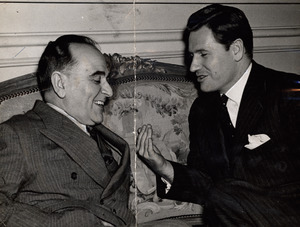
The government wanted Hollywood to make movies that showed good relations with Latin America. Rockefeller asked for changes in some films. He wanted to make sure they were not offensive. Later, Rockefeller helped establish Junior Chamber International. He also convinced his father to donate land in New York City. This land became the site for the United Nations Headquarters.
Assistant Secretary of State (1944–1945)
In 1944, President Roosevelt made Rockefeller the Assistant Secretary of State for American Republic Affairs. In this role, he started a conference in 1945. This meeting created the Act of Chapultepec. This agreement helped countries in the Americas work together. It said that an attack on one country would be an attack on all. Rockefeller signed this agreement for the United States.
He was also part of the U.S. team at the United Nations founding meeting in 1945. He helped make sure that regional agreements, like the Act of Chapultepec, could exist within the UN rules. Rockefeller also helped convince the UN to put its headquarters in New York City. After Roosevelt died, President Truman ended some of Rockefeller's programs.
Improving Economies (1947–1958)
Rockefeller started the International Basic Economy Corporation (IBEC) in 1947. This was a for-profit business. It aimed to help underdeveloped countries grow their economies. He hoped that successful businesses would encourage more local investment. For example, he set up model farms in Venezuela, Ecuador, and Brazil.
In 1950, President Harry S. Truman asked Rockefeller to lead a board. This board planned how to give technical help to other countries. In 1952, President-Elect Dwight D. Eisenhower asked him to find ways to make the government work better. Rockefeller suggested many changes. These led to the creation of the Department of Health, Education and Welfare (HEW). Rockefeller became the Under-Secretary of this new department in 1953. He helped expand the Social Security program.
Foreign Affairs Advisor (1954–1956)
In 1954, Rockefeller became a special advisor to President Eisenhower. His job was to help the President deal with Soviet foreign policy. He was part of the National Security Council. This group oversaw important security plans.
Rockefeller believed that helping other countries financially was important for U.S. safety. He suggested the "open skies" idea. This meant the U.S. and the Soviet Union would let each other fly over their military sites. This would show if either side was building up weapons. It was a way to prevent surprise attacks. However, many of his ideas were blocked by other officials. He resigned from this role in 1956.
In 1956, he started the Special Studies Project. This was a big planning group led by Henry Kissinger. It looked at future challenges for the U.S. One report suggested a large military buildup. This was after the Soviet Union launched Sputnik in 1957. This project started a long friendship between Rockefeller and Kissinger.
Governor of New York (1959–1973)
Rockefeller left the federal government in 1956. He wanted to focus on politics in New York State. In 1958, he was elected governor of New York. He won by a lot of votes. He was re-elected three more times. As governor, he greatly increased the state's role. He focused on education, protecting the environment, transportation, and healthcare. To pay for these programs, he increased taxes. For example, a sales tax was started in New York in 1965. He resigned in 1973 during his fourth term.
Arts and Culture
Rockefeller created the first State Council on the Arts in the country. This became a model for other states. He also oversaw the building of the Saratoga Performing Arts Center. He helped save Olana, the home of artist Frederic Edwin Church.
Buildings and Public Works
Rockefeller started many large building projects in New York. Some people joked he had an "Edifice Complex." He was very involved in the design of these projects. One major project was the US$2 billion South Mall in Albany. It was later renamed the Nelson A. Rockefeller Empire State Plaza. This plaza has many state offices and an egg-shaped arts center. He also supported building the World Trade Center.
Civil Rights
Rockefeller worked to stop discrimination in housing. He also made it illegal to discriminate in jobs based on sex or age. He increased the number of African Americans and Hispanics in state jobs. He appointed many women to lead state agencies. He also supported New York's approval of the Equal Rights Amendment. He banned practices that artificially lowered housing values.
Protecting the Environment
Rockefeller expanded the New York State Parks system. He got voters to approve over $300 million for new park land. He built or started 55 new state parks. He also started studies on environmental issues. He helped create the Adirondack Park Agency. This agency protects the Adirondack State Park. He also launched the Pure Waters Program. This was a state effort to stop water pollution. He banned harmful pesticides like DDT. He created the Department of Environmental Conservation.
Education
Rockefeller was key in making the State University of New York (SUNY) huge. Under his leadership, SUNY grew from 29 campuses to 72 campuses. The number of students also grew a lot. He helped the private University of Buffalo join SUNY. He also created Empire State College. This college helps adults get higher education. He greatly increased state money for schools. He also required special education for children with disabilities.
Housing
To create more affordable housing, Rockefeller created the New York State Urban Development Corporation (UDC). This group had special powers to build housing. By 1973, his administration had built or started over 88,000 homes. These homes were for families with lower incomes and older people.
Other Programs
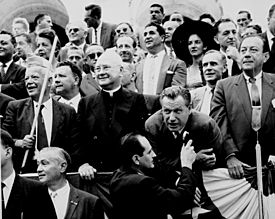
Rockefeller worked to create good pension programs for public workers. These included teachers, police, and firefighters. He proposed the first statewide minimum wage law in the U.S. He also started the state lottery. He improved mental hospitals. He created the State Office of the Aging. He also made the first mandatory seatbelt law in the U.S. He created the State Consumer Protection Board.
Transportation
In 1967, Rockefeller got approval for a huge bond issue ($2.5 billion). This money was for improving transportation. He oversaw the creation or expansion of over 22,000 miles of highways. These included the Long Island Expressway and the Adirondack Northway. He also started state support for public transportation. He created the Metropolitan Transportation Authority (MTA) in New York City. The MTA combined the subway system with other public transport. He also created the State Department of Transportation.
Presidential Campaigns
Rockefeller tried to become the Republican candidate for president three times. These were in 1960, 1964, and 1968.
1960 Election
His attempt in 1960 ended early. Then-Vice President Richard Nixon was far ahead in the polls. After leaving the race, Rockefeller supported Nixon. He worked to add more moderate ideas to Nixon's plans.
1964 Election
Rockefeller was a leading candidate for the 1964 nomination. He was seen as a more liberal Republican. His main opponent was Senator Barry Goldwater, a conservative. In 1963, Rockefeller divorced his first wife. He then married Margaretta "Happy" Murphy, who was also divorced. This upset many Republican voters, especially married women.
He did not do well in early primary elections. He won in Oregon but then narrowly lost in California. The birth of his child just before the California primary brought up the divorce issue again. He then dropped out of the race. At the Republican convention, Rockefeller tried to speak. He wanted to add more moderate ideas to the party's platform. But he was booed and heckled for a long time. He was reluctant to support Goldwater in the general election.
1968 Election
Rockefeller tried for the presidential nomination again in 1968. His opponents were Richard Nixon and Governor Ronald Reagan. Rockefeller represented the liberal side of the party. Nixon won the nomination on the first try.
Vice Presidency (1974–1977)

When President Nixon resigned in August 1974, Vice President Gerald Ford became President. On August 20, Ford chose Rockefeller to be the next Vice President of the United States. Ford thought Rockefeller would bring experience to the government. He also believed Rockefeller could attract support from different groups of people. Ford promised Rockefeller he would be a "full partner" in his presidency.
Rockefeller had to go through long hearings in Congress. It was revealed he had given large gifts to his aides. He also used his money to fund a critical book about a political opponent. He had also taken some questionable tax deductions. He agreed to pay almost a million dollars to settle the tax issue. But no illegal actions were found. He was confirmed as Vice President. Some conservative Republicans voted against him. But most approved his nomination.
The Senate approved him on December 10, 1974, by a vote of 90 to 7. The House approved him on December 19, by 287 to 128. He took office on December 19. Rockefeller was the second person to be appointed Vice President under the 25th Amendment. Ford himself was the first.
Rockefeller often felt that Ford gave him little power. Ford had initially wanted him to lead the Domestic Policy Council. But Ford's staff did not want to share power. Rockefeller was often left out of important decisions. However, Ford did appoint him to lead several commissions. These included a commission on CIA activities.
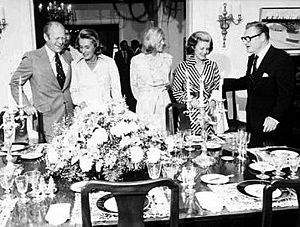
While Rockefeller was Vice President, the official vice presidential residence was set up. This was at Number One Observatory Circle. Rockefeller already had a secure home in Washington. He never lived in the official residence full-time. But he did host many events there. He donated millions of dollars worth of furniture to the house.
Rockefeller was slow to use Air Force Two, the official vice-presidential plane. He preferred to use his own private plane. He thought this saved taxpayer money. But the Secret Service convinced him it was cheaper to fly on Air Force Two with his security team.
1976 Election
President Ford faced challenges from conservative Republicans for the 1976 presidential nomination. He thought about choosing a different running mate. In November 1975, Rockefeller offered to step aside. Ford agreed. Rockefeller said he didn't want to get caught up in party fights.
Ford chose Bob Dole as his running mate instead. Ford later said not choosing Rockefeller was one of his biggest mistakes. He called it "one of the few cowardly things I did in my life." Rockefeller actively campaigned for Ford in the 1976 election. However, Ford lost to Jimmy Carter.
Political Ideas
Rockefeller was known for his practical approach to governing. He didn't stick to one strict political idea. He focused on finding solutions to problems. He wanted to get enough support to make changes happen. His policies were not always strictly liberal or conservative. For example, his early financial policies were conservative. But later ones were not. He made conservative decisions on social programs. But he also made liberal ones on environmental issues.
Conservatives in the Republican Party, like Barry Goldwater, often disagreed with Rockefeller. They saw his views as too liberal. Rockefeller spent more money as governor of New York than his Republican predecessor. He greatly expanded the state's infrastructure. He increased spending on education. He also increased the state's involvement in environmental issues. He had good relationships with unions.
One common criticism of Rockefeller's time as governor was that he did too much too fast. This greatly increased the state's debt. This debt later contributed to New York's financial problems in 1975. He created many public authorities. These groups could issue bonds to raise money without a public vote. The state budget grew a lot during his time. He also raised taxes eight times. New York's tax burden became higher than in any other state.
Helping Others and Art
Rockefeller was chairman of Rockefeller Center, Inc., for many years. He started expanding the center. He and his four brothers started the Rockefeller Brothers Fund in 1940. This was a charity. He also started the American International Association for Economic and Social Development in 1946. This group helped underdeveloped countries with skills and equipment. It aimed to fight illiteracy, disease, and poverty.
Rockefeller was a trustee of the Museum of Modern Art from 1932 to 1979. He also served as its president. In 1933, he helped choose art for the new Rockefeller Center. He wanted a modern artist like Henri Matisse or Pablo Picasso to paint a mural. But they were not available. He then chose Diego Rivera. Rivera painted a mural called Man at the Crossroads. But it caused a lot of controversy. It included a painting of Lenin. Rockefeller asked Rivera to change it, but he refused. The mural was then covered and later destroyed.
Rockefeller was a famous collector of modern art. He also collected art from non-Western cultures. While governor, New York State bought many artworks for the new Empire State Plaza. He continued his mother's work at the Museum of Modern Art. He turned the basement of his mansion into an art gallery. He also placed sculptures around his property. He enjoyed moving them around by helicopter. He also helped build the Neuberger Museum at the State University of New York at Purchase.
His early trips to Mexico made him interested in pre-Columbian art. He also collected African and Pacific Island art. In 1954, he started the Museum of Primitive Art. This museum focused on art from indigenous cultures. His personal collection formed the core of the museum. In 1969, he gave the museum's collection to the Metropolitan Museum of Art. It became the Michael C. Rockefeller Collection.
In 1977, he started Nelson Rockefeller Collection, Inc. This company made and sold copies of art from his collection. He wanted to share "the joy of living with these beautiful objects."
Personal Life
On June 23, 1930, Rockefeller married Mary Todhunter Clark. They had five children: Rodman, Ann, Steven, Michael, and Mary. His son Michael disappeared in New Guinea in November 1961. He is believed to have drowned.
Nelson and Mary Rockefeller divorced in 1962. On May 4, 1963, Rockefeller married Margaretta Large "Happy" Fitler. They had two sons: Nelson Jr. and Mark. They remained married until his death.
Death
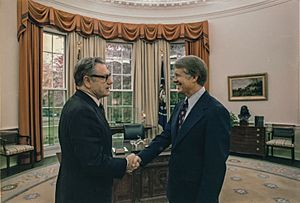
Nelson Rockefeller died on January 26, 1979. He had a heart attack. He was 70 years old. An early report said he died at his office. But it was later corrected. He actually had the heart attack at a townhouse he owned. A 25-year-old aide was with him. She called a friend, who then called an ambulance about an hour later.
Rockefeller's body was cremated. His ashes were buried in the Rockefeller family cemetery in Sleepy Hollow, New York. A memorial service was held in New York City. President Jimmy Carter and Henry Kissinger attended.
Legacy
Many awards and places are named after Nelson A. Rockefeller. These honor his contributions to public service, arts, and the environment.
Awards Named After Rockefeller
- Nelson A. Rockefeller Award, Purchase College School of the Arts.
- Governor Nelson A. Rockefeller Award for Excellence in Public Service.
- Nelson A. Rockefeller Distinguished Public Service Award, Dartmouth College.
- Nelson A. Rockefeller Award, American Society for Public Administration.
- Nelson A. Rockefeller Award, The New York Water Environment Association.
- Nelson A. Rockefeller Public Service Award, Rockefeller Institute of Government.
Awards He Received
- Presidential Medal of Freedom, 1977.
- Universal Brotherhood Medal, 1961.
- Charles Evans Hughes Medal, 1965.
- Distinguished Service to Conservation Award, 1966.
- Gold Medal Award, National Institute of Social Sciences, 1967.
- Award of Merit, American Institute of Architects, 1968.
- Distinguished Service Award, State University of New York, 1973.
- Four Freedoms Foundation Award, 1974.
- He also received many international awards from countries like Chile, Brazil, Mexico, France, and the Netherlands.
Memorials
Several places are named in his honor:
- The Nelson A. Rockefeller Center for Public Policy and the Social Sciences, Dartmouth College.
- The Nelson A. Rockefeller Collegiate Center, Binghamton University, New York.
- Rockefeller College of Public Affairs and Policy, University at Albany, State University of New York.
- The Governor Nelson A. Rockefeller Empire State Plaza.
- Nelson A. Rockefeller Park, Battery Park City, New York City.
- P.S. 121 in Brooklyn, NY, was renamed Nelson A. Rockefeller Elementary School.
- Rockefeller Institute of Government, a public policy research center.
Images for kids
See also
 In Spanish: Nelson Rockefeller para niños
In Spanish: Nelson Rockefeller para niños



